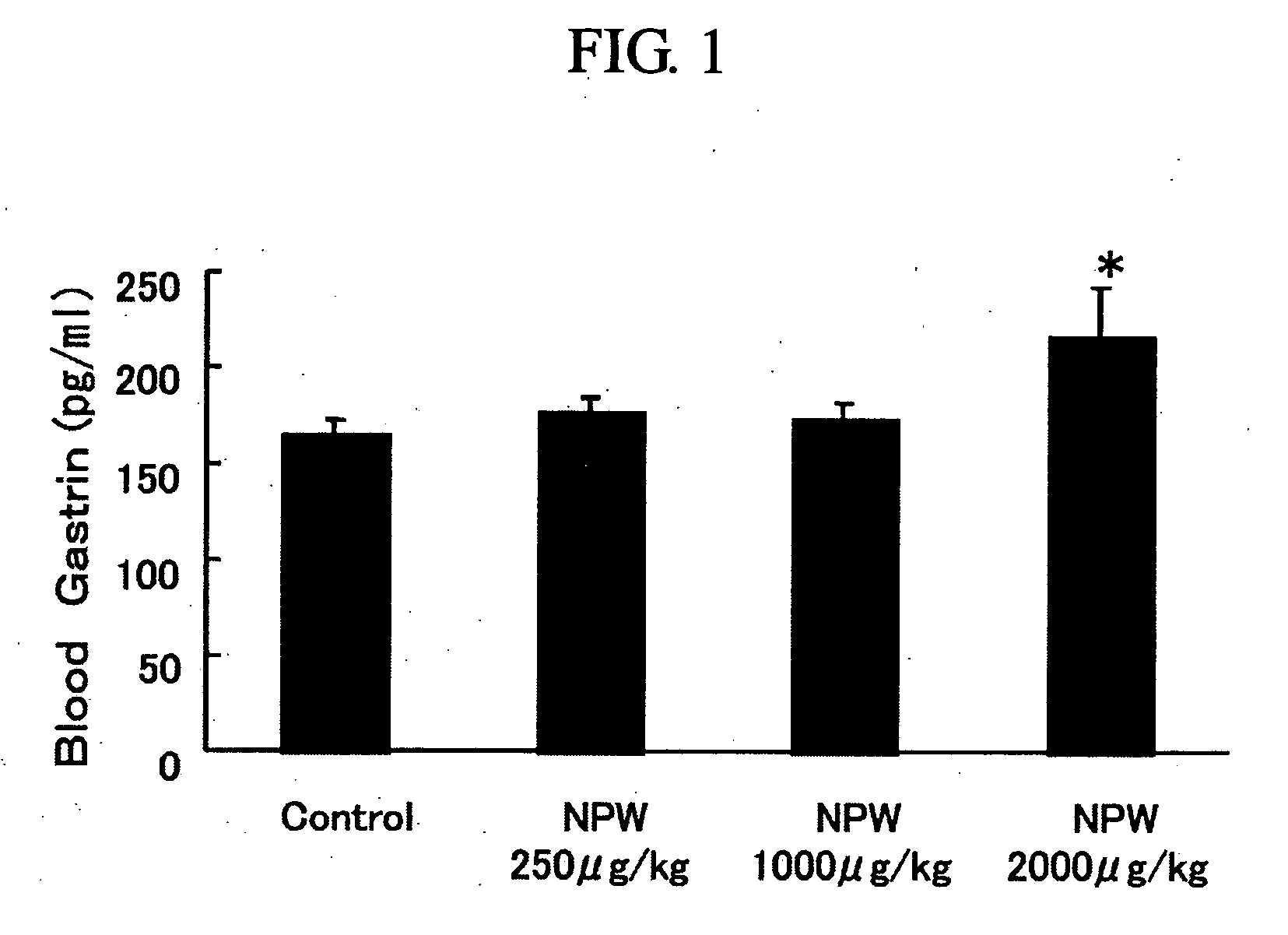Agents for preventing and/or treating uppper digestive tract disorders
- Summary
- Abstract
- Description
- Claims
- Application Information
AI Technical Summary
Benefits of technology
Problems solved by technology
Method used
Image
Examples
reference example 1
Production of [Phe2] Human GPR8 Ligand (1-20) (SEQ ID NO: 71)
[0548] Following a program, a peptide chain was extended from the C terminus on an automated peptide synthesizer (ABI 433 model) of Applied Biosystems, Inc. in accordance with a sequential Fmoc strategy to synthesize the objective peptide resin protected.
[0549] Using Wang (p-benzyloxybenzyl alcohol) resin (0.25 mmol) as the starting amino acid resin carrier, Fmoc-amino acid derivatives of Fmoc-Leu, Fmoc-Gly, *Fmoc-Ala, Fmoc-Arg(Pbf), Fmoc-Val, Fmoc-Thr(But), Fmoc-His(Trt), Fmoc-Tyr(But), Fmoc-Pro, Fmoc-Ser(But), Fmoc-Lys(Boc), Fmoc-Phe and Fmoc-Trp(Boc) were sequentially condensed on the carrier by HBTU (2-(1H-benzotriazol-1-yl)-1,1,3,3-tetramethyluronium hexafluorophosphate), according to the sequence.
[0550] After construction of the peptide on the resin was completed, the protected peptide resin was dried. Deprotection of the protected peptide obtained and release of the peptide from the resin carrier were accomplishe...
reference example 2
Production of [Phe2,125I-Tyr10] Human GPR8 Ligand (1-20) Using the Lactoperoxidase Method
[0554] In 10 μl of DMSO, 10 nmol of [Phe2] human GPR8 ligand (1-20) (SEQ ID NO: 71) obtained by a modification of the process described in REFERENCE EXAMPLE 1 was dissolved. The resulting solution was mixed and reacted with 10 μl of 0.1 M nickel chloride aqueous solution, 10 μl of 0.001% aqueous hydrogen peroxide in 0.1 M HEPES (pH 7.6), 10 μl of 10 μg / ml lactoperoxidase (Sigma) in 0.1 M HEPES (pH 7.6) and 10 μl of [125I] NaI-40 MBq (NEN Life Science Products) at room temperature for 50 minutes. The produced [Phe2, 125I-Tyr10] human GPR8 ligand (1-20) was fractionated on HPLC under the following conditions.
[0555] The column used was ODS-80TM (4.6 mm×15 cm) (Toso Corporation); using 10% acetonitrile / 0.1% TFA as Eluent A and as Eluent B 60% acetonitrile / 0.1% TFA, gradient elution with 0-0 (2 min), 0-27 (5 min) and 27-32 (40 min) % B / A+B was performed. The conditions were set for the flow rate of...
example 1
Effects on Gastric Acid Secretion in Rat by Intravenous Injection of hNPW23
[0556] After Wistar male rats (Nippon Charles River, weighing 320-360 g) were fasted for 16 hours with water given ad libitum, the animal was injected intraperitoneally with ethyl carbamate (Wako Pure Chemical) (1.0 g / ml / kg) and firmly secured to the operating table under anesthesia to perform laparotomy. Stomach catheter (Medtop X2-50, 3.5 mm in outer diameter and 21 mm in inner diameter) was inserted into the stomach (2 cm) through an incision in the duodenum. After ligature at the pyloric canal, the right femoral vein was isolated to perform venous cannulation. The stomach was irrigated with distilled water (Otsuka Pharmaceutical Co., Ltd.) warmed at 37° C. and allowed to stand for about an hour. hNPW23 was dissolved in saline (Otsuka Pharmaceutical Co., Ltd.) to become 80 μM. The control group was given saline. Test was performed with 8 rats in each group. hNPW23 and saline were given to the animal at a ...
PUM
 Login to view more
Login to view more Abstract
Description
Claims
Application Information
 Login to view more
Login to view more - R&D Engineer
- R&D Manager
- IP Professional
- Industry Leading Data Capabilities
- Powerful AI technology
- Patent DNA Extraction
Browse by: Latest US Patents, China's latest patents, Technical Efficacy Thesaurus, Application Domain, Technology Topic.
© 2024 PatSnap. All rights reserved.Legal|Privacy policy|Modern Slavery Act Transparency Statement|Sitemap

